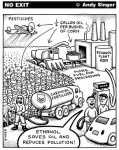Below is an artificial I read recently about Ethanol-free fuel, take it for what its worth, everyone has a different opinion. If you find any good in it o.k., if not no sleep lost.
Dick
USE ETHANOL-FREE FUEL IN YOUR SMALL ENGINES
Guest Article for the Tallahassee Democrat
Photo by Deborah Lawson
July 19, 2013, Release for Tallahassee Democrat
By Deborah Lawson

As seems to be the case with many things in this fast paced world, often politics and public relations sound bites prevail over science and factual information. We are so excited to find solutions that we fail to take the time to accumulate evidence over time. The result is public policy based being made before results of the policy are completely understood. I believe this was the case with the Federal Renewable Fuel Standards Act which went into effect in 2007 and requires increasing amounts of ethanol to be mixed with the gasoline supply, currently 10 percent. In 2008 the Florida Legislature followed suit, passing a requirement that gasoline sold in Florida contain 10 percent alternative "blended" fuels. This year the Florida Legislature repealed the Florida requirement, but we still have to deal with the Federal mandate.
The Environmental Protection Agency has now approved gasoline with 15 percent ethanol (E15) for use in cars year 2001 or newer, yet it prohibits its use in mowers and other power equipment, stating it may cause damage. A Department of Energy study found that E15 caused hotter operating temperatures, erratic running, and engine-part failure. The reality is, even gas with the usual 10 percent ethanol (E10) is causing premature repairs and small engine failures nationwide.
Even for the most environmentally green individual, the evidence is in and the damage caused by ethanol to mowers, blowers, chain saws, generators, marine and other small engines is extensive. Fuel stabilizers were initially thought to help, but the bottom line is - they're just not enough!
What happens when you use E10 in your small two-cycle engine? The ethanol creates a chain reaction of events that end up clogging valves and rusting out small metal parts, especially carburetors. The ethanol actually attracts moisture and causes a quicker deterioration of the fuel as well as corrosion. In addition, the alcohol actually dissipates the oil you mix with the fuel which is intended to lubricate the small engine, but instead the oil is being pushed away and is not lubricating the engine.
All of this creates a gummy residue called shellack that clogs filters and hoses. The engine ends up starving for gas because it's stopped up with the gel created when the shellack breaks down.
Another interesting phenomenon, Asian Ambrosia beetles are attracted to ethanol. It is actually being utilized as bait where infestations have occurred. Recently our gas tank on our mower had to be replaced because the beetles had eaten pin holes in it to get to the ethanol. Who'd have thought….?
Bottom line, IT IS worth taking the extra time and spending a little more money to fill your gas cans with ethanol-free gasoline for use in your two-cycle engines. Look for gas stations that sell marine fuel. Some Tallahassee area stations include Maxwell's BP at Mahan and Chaires, Eli Roberts on Lake Bradford Road, and the Shell station on the north side of West Tennessee Street near ABC Liquors. If you only use a small amount, ethanol-free fuel can be purchased in quart cans at places like Tractor Supply and most lawn equipment stores, but it's an expensive way to buy it.
Dick
USE ETHANOL-FREE FUEL IN YOUR SMALL ENGINES
Guest Article for the Tallahassee Democrat
Photo by Deborah Lawson
July 19, 2013, Release for Tallahassee Democrat
By Deborah Lawson

As seems to be the case with many things in this fast paced world, often politics and public relations sound bites prevail over science and factual information. We are so excited to find solutions that we fail to take the time to accumulate evidence over time. The result is public policy based being made before results of the policy are completely understood. I believe this was the case with the Federal Renewable Fuel Standards Act which went into effect in 2007 and requires increasing amounts of ethanol to be mixed with the gasoline supply, currently 10 percent. In 2008 the Florida Legislature followed suit, passing a requirement that gasoline sold in Florida contain 10 percent alternative "blended" fuels. This year the Florida Legislature repealed the Florida requirement, but we still have to deal with the Federal mandate.
The Environmental Protection Agency has now approved gasoline with 15 percent ethanol (E15) for use in cars year 2001 or newer, yet it prohibits its use in mowers and other power equipment, stating it may cause damage. A Department of Energy study found that E15 caused hotter operating temperatures, erratic running, and engine-part failure. The reality is, even gas with the usual 10 percent ethanol (E10) is causing premature repairs and small engine failures nationwide.
Even for the most environmentally green individual, the evidence is in and the damage caused by ethanol to mowers, blowers, chain saws, generators, marine and other small engines is extensive. Fuel stabilizers were initially thought to help, but the bottom line is - they're just not enough!
What happens when you use E10 in your small two-cycle engine? The ethanol creates a chain reaction of events that end up clogging valves and rusting out small metal parts, especially carburetors. The ethanol actually attracts moisture and causes a quicker deterioration of the fuel as well as corrosion. In addition, the alcohol actually dissipates the oil you mix with the fuel which is intended to lubricate the small engine, but instead the oil is being pushed away and is not lubricating the engine.
All of this creates a gummy residue called shellack that clogs filters and hoses. The engine ends up starving for gas because it's stopped up with the gel created when the shellack breaks down.
Another interesting phenomenon, Asian Ambrosia beetles are attracted to ethanol. It is actually being utilized as bait where infestations have occurred. Recently our gas tank on our mower had to be replaced because the beetles had eaten pin holes in it to get to the ethanol. Who'd have thought….?
Bottom line, IT IS worth taking the extra time and spending a little more money to fill your gas cans with ethanol-free gasoline for use in your two-cycle engines. Look for gas stations that sell marine fuel. Some Tallahassee area stations include Maxwell's BP at Mahan and Chaires, Eli Roberts on Lake Bradford Road, and the Shell station on the north side of West Tennessee Street near ABC Liquors. If you only use a small amount, ethanol-free fuel can be purchased in quart cans at places like Tractor Supply and most lawn equipment stores, but it's an expensive way to buy it.





